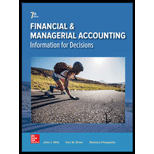
Concept explainers
The assets, liabilities and equity relation is known as the accounting equation. Assets are the resources of company and that increase as business expand whereas liabilities are the burden on company that has to pay in future; Equity means the owner claim on assets. An accounting equation represent the assets of the company are equal to the liabilities and equity of the company.
In can be represented as follow:
Assets:
Assets are the resources that a company needs to run the business. An asset is economic resources of the company.
Liabilities:
Liabilities are generally the amount owned by the company from lenders, suppliers, or bank. Liabilities are the burden on the company that they have to pay to others.
Equity:
The Company needs finance to run the business. Equity is one of the method through which the company raise the capital.
To Identify: The effect of transactions on the accounting equation.
Trending nowThis is a popular solution!

Chapter 1 Solutions
GEN COMBO LOOSELEAF FINANCIAL AND MANAGERIAL ACCOUNTING; CONNECT ACCESS CARD
- Need answer the financial accounting questionarrow_forwardDuring 2015, the assets of Inspiring Sky increased by $45,000, and the liabilities increased by $20,000. If the owner's equity in Inspiring Sky is $100,000 at the end of 2015, the owner's equity at the beginning of 2015 must have been __.Answer this questionarrow_forwardPlease provide answer this general accounting questionarrow_forward
- During 2015, the assets of Inspiring Sky increased by $45,000, and the liabilities increased by $20,000. If the owner's equity in Inspiring Sky is $100,000 at the end of 2015, the owner's equity at the beginning of 2015 must have been __.arrow_forwardSummit Steelworks Ltd. reported the following year end information: please answer the general accounting questionarrow_forwardBuffalo Inc. issued $4,200,000 of convertible 5-year bonds on July 1, 2025. The bonds provide for 6% interest payable semiannually on January 1 and July 1. The discount in connection with the issue was $102,000, which is being amortized monthly on a straight-line basis. The bonds are convertible after one year into 15 shares of Buffalo Inc's $1 par value common stock for each $1,000 of bonds. On October 1, 2026, $504,000 of bonds were turned in for conversion into common stock. Interest has been accrued monthly and paid as due. At the time of conversion, any accrued interest on bonds being converted is paid in cash. Prepare the journal entries to record the conversion, amortization, and interest in connection with the bonds as of the following dates.arrow_forward
- Buffalo Inc. issued $4,200,000 of convertible 5-year bonds on July 1, 2025. The bonds provide for 6% interest payable semiannually on January 1 and July 1. The discount in connection with the issue was $102,000, which is being amortized monthly on a straight-line basis. The bonds are convertible after one year into 15 shares of Buffalo Inc's $1 par value common stock for each $1,000 of bonds. On October 1, 2026, $504,000 of bonds were turned in for conversion into common stock. Interest has been accrued monthly and paid as due. At the time of conversion, any accrued interest on bonds being converted is paid in cash. Prepare the journal entries to record the conversion, amortization, and interest in connection with the bonds as of the following dates. (Credit account titles are automatically indented when amount is entered. Do not indent manually. If no entry is required, select "No Entry" for the account titles and enter O for the amounts. List all debit entries before credit entries.arrow_forwardhttps://view.officeapps.live.com/op/view.aspx?src=https%3A%2F%2Flectures.mhhe.com%2Fconnect%2Frichardson_iba_1e_1265454345%2Fdata_files%2Fch2%2FIBA_Lab2-4_Alt_Data.xlsx&wdOrigin=BROWSELINK make a pivot table and pivot chart to assess the sum of raw materials quantity purchased by year. make a slicer to interactively filter the pivot chart by state from which the products were ordered. Adjust the pivot chart to show horizontal bararrow_forwardSolve this following requirementsarrow_forward

 AccountingAccountingISBN:9781337272094Author:WARREN, Carl S., Reeve, James M., Duchac, Jonathan E.Publisher:Cengage Learning,
AccountingAccountingISBN:9781337272094Author:WARREN, Carl S., Reeve, James M., Duchac, Jonathan E.Publisher:Cengage Learning, Accounting Information SystemsAccountingISBN:9781337619202Author:Hall, James A.Publisher:Cengage Learning,
Accounting Information SystemsAccountingISBN:9781337619202Author:Hall, James A.Publisher:Cengage Learning, Horngren's Cost Accounting: A Managerial Emphasis...AccountingISBN:9780134475585Author:Srikant M. Datar, Madhav V. RajanPublisher:PEARSON
Horngren's Cost Accounting: A Managerial Emphasis...AccountingISBN:9780134475585Author:Srikant M. Datar, Madhav V. RajanPublisher:PEARSON Intermediate AccountingAccountingISBN:9781259722660Author:J. David Spiceland, Mark W. Nelson, Wayne M ThomasPublisher:McGraw-Hill Education
Intermediate AccountingAccountingISBN:9781259722660Author:J. David Spiceland, Mark W. Nelson, Wayne M ThomasPublisher:McGraw-Hill Education Financial and Managerial AccountingAccountingISBN:9781259726705Author:John J Wild, Ken W. Shaw, Barbara Chiappetta Fundamental Accounting PrinciplesPublisher:McGraw-Hill Education
Financial and Managerial AccountingAccountingISBN:9781259726705Author:John J Wild, Ken W. Shaw, Barbara Chiappetta Fundamental Accounting PrinciplesPublisher:McGraw-Hill Education





